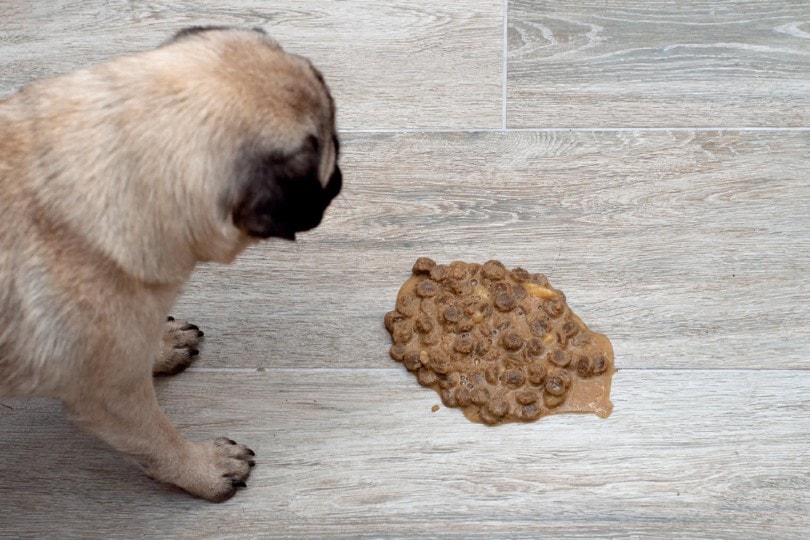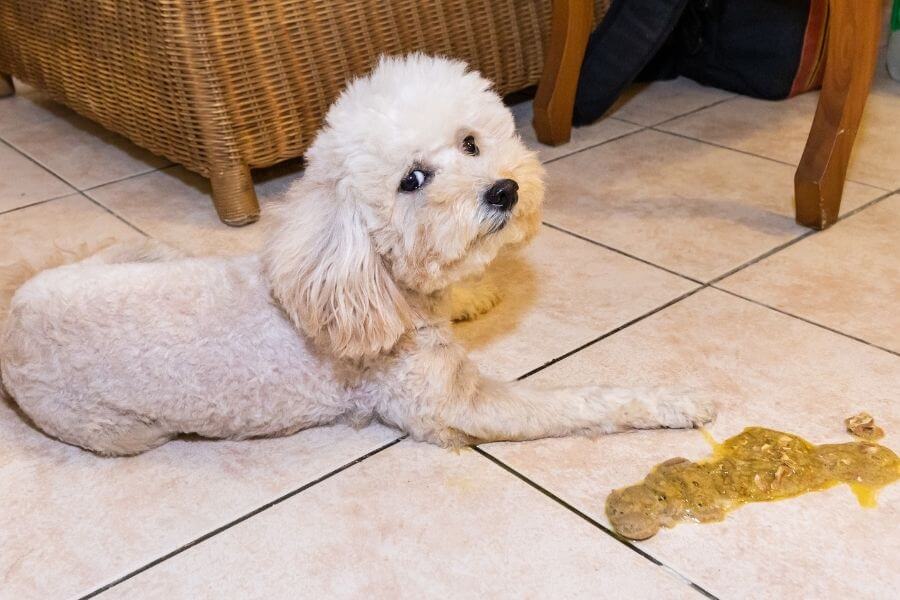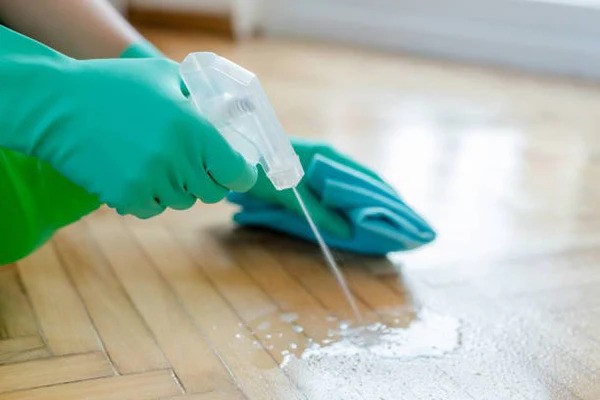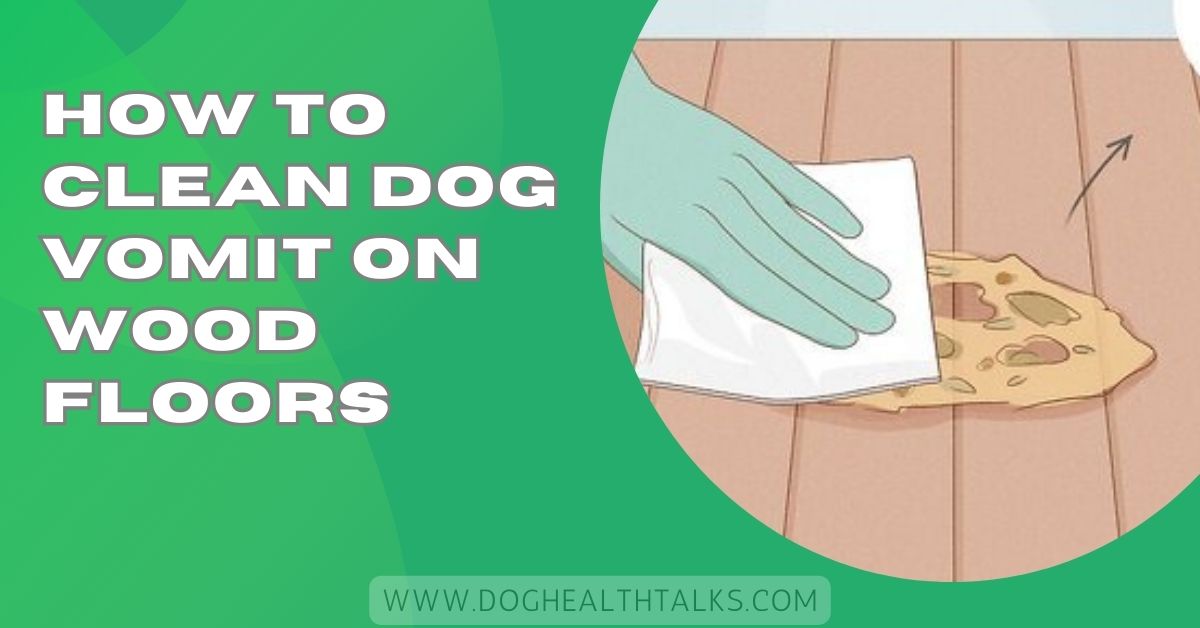Every dog owner has faced the unpleasant surprise of finding vomit on the floor. While it’s never enjoyable to clean, it becomes more stressful when the accident happens on hardwood flooring.
To clean dog vomit on wood floors, remove solids, blot with paper towels, then use an enzymatic cleaner or hydrogen peroxide. For stubborn stains, lightly sand and refinish the affected hardwood area safely.
In this guide, you’ll learn exactly how to clean dog vomit on wood floors naturally, from quick clean-up steps to long-term care tips.
Hardwood floors are beautiful, but they are also vulnerable. Dog vomit contains stomach acids that can seep into the surface, leaving permanent stains or even warping the wood.
If the vomit sits for too long, it may cause discoloration, foul odors, and long-term damage. Unlike tile or vinyl, wood is porous, which means it absorbs liquids easily. This is why immediate and proper cleaning is essential.

- Put on disposable gloves to protect your hands.
- Remove any solid pieces of vomit with a paper towel or plastic scraper—lift gently to avoid smearing.
- Blot the area with a clean, absorbent cloth to soak up as much liquid as possible. Do not rub, as this can push vomit into the wood grain.
- Mix a solution of equal parts white vinegar and warm water in a spray bottle. Lightly mist the area.
- Wipe gently with a soft cloth, repeating until the residue is gone.
- If needed, add a few drops of mild dish soap to warm water and clean the spot again.
- Rinse the area lightly with a damp cloth (just water, no solution).
- Dry immediately with a fresh towel to prevent moisture from seeping into the wood.
- For lingering odor, sprinkle baking soda over the area, let it sit for a few hours, then vacuum.
- Once the spot is dry, apply a small amount of wood-safe polish or oil to restore shine and protection.
When you discover vomit on your hardwood floor, time is of the essence. First, protect yourself by putting on disposable gloves.
Next, carefully remove any solid matter with a paper towel or plastic scraper—avoid pressing too hard, as this can push the mess into the wood grain.
Once the solids are cleared, blot the area gently with an absorbent cloth. The key here is blotting, not rubbing, to prevent the vomit from spreading or becoming embedded deeper into the floor.
Before starting the full clean-up process, gather the right supplies. A few simple items from your home can do the job safely:
- Soft microfiber cloths or old towels
- A bowl of warm water
- White vinegar (diluted)
- Baking soda
- Mild dish soap (wood-safe)
- A spray bottle
- A small brush with soft bristles
Avoid using bleach, ammonia, or steam cleaners, as these can damage the wood’s protective finish.

After removing solids, gently press a clean cloth on the area to soak up moisture. Blotting prevents liquid from spreading across the floor or into the seams.
Mix equal parts white vinegar and warm water in a spray bottle. Lightly mist the affected area, then wipe with a clean cloth.
Vinegar neutralizes odor-causing bacteria without harming the wood when used in an appropriately diluted solution.
If the vinegar doesn’t remove all residue, mix a few drops of mild dish soap in warm water. Dip a soft cloth into the solution and gently wipe the area. Avoid over-wetting the wood; too much water can cause swelling or warping.
After cleaning, immediately dry the area with a fresh towel. For added protection, you can apply a small amount of mineral oil or wood polish once the spot is dry. This helps restore the shine and prevents future staining.
Natural methods are not only safer for pets but also gentle on hardwood. Vinegar, baking soda, and mild soap are excellent choices for everyday accidents. Baking soda, for example, can be sprinkled over the spot after cleaning to absorb lingering odors.
Commercial cleaners, on the other hand, can be helpful if the vomit has left behind a stubborn stain. Look for pet-safe hardwood cleaners that specifically mention being non-toxic and safe for sealed wood floors.
If a light stain remains after cleaning, make a paste with baking soda and water. Gently apply the solution to the stain, leave it for 10 minutes, then wipe clean.
For darker or deeper stains, you may need to sand the area and reapply a wood finish lightly. If the damage is severe or widespread, contacting a professional floor specialist may be the safest option.
Odors can be just as frustrating as stains. To keep your home smelling fresh:
- Sprinkle baking soda over the area after cleaning, let it sit overnight, then vacuum.
- Improve air circulation with fans or open windows.
- Use pet-safe odor sprays designed for hardwood floors.
These simple steps prevent smells from settling into the wood fibers.

Accidents happen, but you can reduce the impact with some preventative measures:
- Apply a protective sealant to your hardwood floors to make them more resistant to liquids.
- Place washable rugs or mats in areas where your dog spends the most time.
- Keep your dog on a balanced diet to minimize digestive issues that may cause vomiting.
- Trim your dog’s nails regularly to prevent scratches when they move around during accidents.
If you notice discoloration, foul odors that persist, or damage to the wood’s finish, it may be time to seek professional help.
Hardwood specialists have the right equipment and techniques to restore the flooring without causing further harm.
Start by scooping up solids with paper towels, then blot the area with a damp cloth. Use a mild cleaner mixed with warm water to wipe away residue.
Dry the spot altogether to avoid moisture damage, and sprinkle baking soda if any odor lingers.
Quickly remove solids with a paper towel, then wash the spot with warm soapy water. Tile is durable, so you can safely use a disinfectant or vinegar solution. Rinse with clean water, dry thoroughly, and open windows to keep the area fresh and odor-free.
Blot up as much liquid as possible without rubbing, then apply a mix of warm water and mild dish soap.
Gently scrub with a soft brush until the stain lifts. Sprinkle baking soda to absorb odors, let it sit overnight, and vacuum once dry.
After cleaning the vomit, lightly spray a diluted vinegar solution to neutralize odors. Dry the wood quickly with a towel to avoid moisture damage.
For extra freshness, sprinkle baking soda over the spot, leave it for a few hours, then vacuum it away carefully.
Carefully scrape off dried vomit with a plastic scraper, then wipe the area with a vinegar and warm water solution.
If stains remain, use a paste of baking soda and water. Dry immediately to protect the wood, and finish with a little wood polish.
Gently remove solids, blot liquid, then clean with a vinegar-water mix. Dry the area quickly to prevent stains, odor, and wood damage.
Always clean vomit while it is wet. Once it dries, acids and stains set deeper, making removal more challenging. Quick action protects surfaces and reduces lasting smells.
Undiluted vinegar can dull hardwood finishes. Always mix it with water before use, and avoid frequent cleaning this way to keep floors safe.
Clean thoroughly, then sprinkle baking soda over the area. Let it sit for hours, vacuum it up, and finish with a safe wood polish.
Yes, but always dilute vinegar with water. It naturally neutralizes odors and bacteria without harsh chemicals, making it safe for both pets and floors.
Scoop solids, blot liquid, and wash with warm soapy water. Rinse lightly, dry completely, and sprinkle baking soda to remove odors. Avoid rubbing stains.
Blot first, then scrub with a mild soap and water mix. For stubborn spots, apply baking soda paste, let it sit, and gently wipe clean.
Yes, baking soda safely absorbs odors from hardwood. Sprinkle over the spot, leave for hours, then vacuum. Always dry floors immediately afterward.
Loosen dried bile with warm water, then scrub gently using dish soap. Apply baking soda overnight, vacuum, and repeat if needed for stubborn discoloration.
Blot moisture, then clean with a vinegar-water solution. Sprinkle baking soda, let it sit overnight, vacuum, and finish with a fabric-safe freshening spray.
Cleaning dog vomit from wood floors may not be pleasant, but acting quickly and using safe, natural methods makes the process simple and effective. By removing solids, blotting gently, and using solutions like vinegar or baking soda, you can protect your hardwood from stains and odors. Long-term care, such as sealing floors and using rugs, helps prevent lasting damage. With these easy steps, you’ll keep your home fresh, your floors shining, and your pets safe—all without harsh chemicals.
